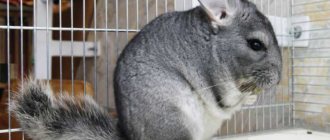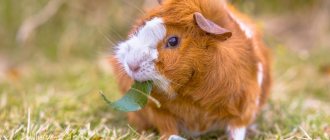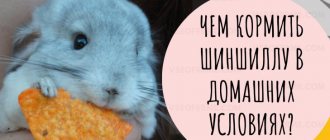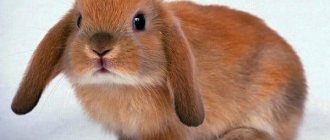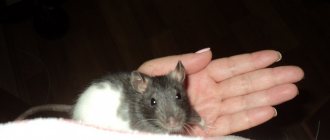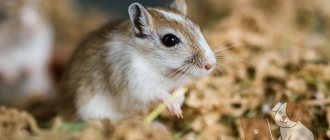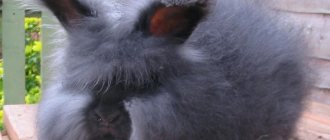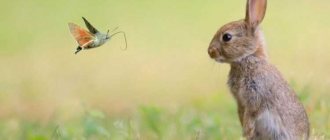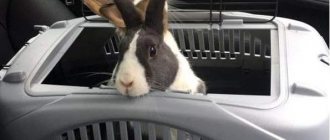After birth, children get confused: they scream, squeal, look for food, for their mother. Newborns already have fur, long whiskers and a bristly tail, which sets them apart from other rodent puppies. Sand flies, rats and hamsters are born hairless.
The fur of newborns is wet, so measures must be taken to dry the animals. Otherwise, they may catch a cold, get sick and die.
Once the young are dry, they crawl under the female's belly, where they feel safe, eat and sleep. After 2-3 hours, you can begin the countdown: you will need to wash the young and mother in warm soapy water, get rid of the consequences of childbirth, throw away the dead young, weigh the living one and determine its gender. This must be documented electronically or in writing (as appropriate).
For water treatments, use only laundry soap, as toilet soap leaves an odor on the newborn's coat, and if the mother smells something else, she may refuse to feed the chinchilla.
Puppies immediately see the world around them because they are born with vision; cases of blind puppies are rare. Most often, closed eyes are caused by something getting into them: hair, fluff. If this situation occurs, the eyes should be washed with a damp cotton swab. Eyes should be washed with infusion of chamomile and black tea without additives.
After 4-5 hours, you need to check the puppy's anus. The owner should notice that the puppy has gone to the toilet, as evidenced by the remains of feces on the fur. This is a good sign and indicates intestinal motility. Otherwise, rectal prolapse and inflammation of the anus will occur.
It is impossible to solve the problem alone without the appropriate qualifications. If the intestines are displaced, vital organs can be easily damaged, and if the inflammation is relieved, the disease can develop into a more severe form. The child should be immediately taken to an experienced specialist; only a veterinarian can help the newborn.
Be sure to monitor your weight and record data. A newborn weighs about 50 grams. At first you will have to weigh the children every day. They will initially lose a few grams, but will quickly return to gaining weight over the next 24 hours.
If the female has problems with lactation, the milk is too thick, the young may continue to lose weight, which will be noticeable when weighed daily. In this case, it will be necessary to switch to artificial feeding: regular baby milk will do, which should be independently regulated with a pipette.
Hard breast milk returns to normal after 3 days. You can try to speed up this process by feeding dry nettle to your chinchilla. Some owners use the medicine Apilak when the leaves do not have the desired effect.
It is much worse when there is no milk at all, then you have to feed the offspring by hand, and they need food every 2 hours after birth. Later they will eat less frequently, but for the first two weeks you will have to take time off to care for your newborn.
For the first time, a chinchilla manages to give birth to only 1-2 young ones, while a more experienced female gives birth to 3-6 young ones. Naturally, the animal has 2 active nipples, although there are cases when 4 nipples are functioning.
For this reason, when there are relatively many young animals in the litter, it is necessary to alternately feed them independently of each other. Otherwise, the strong will beat the weak and keep them away from their mother's breast.
For small animals, prepare a separate box of sawdust as bedding. Be sure to provide a table lamp for the offspring of four-legged animals. It is worth equipping the container with a cardboard box in which the puppies will hide from the intrusive light of the lantern - this will help avoid overheating.
No one is allowed to visit babies before they are one month old, as rodents at this age are susceptible to infectious diseases, and small animals can easily get injured. Infants should be cared for and weighed by only one person, and only one person should perform pre-hygiene procedures.
Recommendations for setting up a cage for cubs
Active puppies can often get hurt, so dangerous situations should be avoided. The chinchilla and offspring should be moved to a hamster cage with bars no more than 1 cm apart, or the mother's house should be lined with a fine mesh cage. All accessories must be removed from the cage; it is important to exclude any possibility of the young animals escaping outside.
Feeders and drinkers should be placed at low heights so that infants have access to food and water. It is important to teach them to feed themselves from an early age. If there is a place for artificial feeding, it is necessary to install an additional milk absorber.
Clean the cage daily: change the bedding, clean and update the feeders and drinkers. To prevent intestinal diseases, it is recommended to wipe the cage floor with salicylic alcohol.
How to Handle Cubs
When the female leaves the nest after giving birth, the owner needs to remove the puppies with disinfected hands and remove the dead ones (if any). Hand washing is only allowed with laundry soap; perfumed soap will leave a smell on the cubs and scare away the female.
Babies left outside the nest need to be dried, warmed, given a drink from a pipette and placed with their mother.
After 24 hours, all newborns need to be weighed: the weight norm is from 30 to 70 g. The procedure is carried out every day at the same hour. Usually puppies gain one gram at a time. If it is less, additional feeding will help, or switching to artificial feeding (if the chinchilla has a small amount of milk).
Children are separated from their mother after 30 days, grouping heterosexual flocks. Young animals are fed with boiled and warm cow's milk for up to six months.
Chinchilla pregnancy. Peculiarities
If your pet is 7 months old, weighs at least 500 grams, and the male is 6 months old, then mating is possible. In order to correctly and timely help a pregnant chinchilla, it is necessary to keep records of the mating date, heat and actual mating of the animals. Animals' weight should also be monitored throughout the adoption and pregnancy period. This monitoring will help you better determine your stop date. Gestation in chinchillas usually lasts from 105 to 125 days.
Chinchilla after childbirth: possible complications
While watching chinchillas give birth, their owners had to deal with similar complications:
- Long labor. This may be due to illnesses suffered during pregnancy or malnutrition. These abnormalities usually occur in young females or are the result of developmental abnormalities. Animals can be helped by gently massaging the abdominal cavity. After giving birth, the chinchilla recovers quickly.
- Puppy injuries. In the first case, the newborn cannot free himself from the foil while the mother gives birth to another puppy. You need to tear the foil with your fingers and clean the baby's muzzle with an ear stick. In the second case, the woman damages the fetus with her teeth, pulling it out. It is necessary to apply medicinal ointment to the wounds.
- Abnormal output of the puppy. If the fetus comes out backwards, there is a risk that it will get stuck and the female will die. Hold the puppy's paws, hold the mother's tummy, and gently pull him out.
- Milk fever. The disease is associated with calcium deficiency, manifested in the form of spasms throughout the body. The animal should be administered 10% calcium gluconate in 0.3 ml, diluted in 1 ml of saline.
Sometimes problems arise and human assistance is required, for example in the following cases:
- Three or four chinchillas fight among themselves for their mother's nipples.
- The female never produces (disappears) milk
- Female chinchilla behaves aggressively towards offspring
Let's look at the cases in more detail.
Chinchillas fight over female nipples
The female has four out of six working nipples. They are located on the stomach on the sides closer to the armpits and hind legs of the animal. If the female previously had only one baby, then the next litter will receive only one “developed” nipple. When three or four babies are born, competition for nipples arises. Chinchillas fight with each other for a place under the female. Cute furry creatures can be fierce when fighting for food, biting and injuring each other. The weakest among them suffer the most. Check babies for injuries. The solution to the problem is to place chinchillas with the female one at a time. And in the first days you will still need to feed them artificially.
The female has lost her milk
Five or more days pass and the milk still does not appear. If the female does not produce milk for more than 10 days, most likely there will be none. The chinchilla will have to be fed artificially or placed with another lactating female.
Mother chinchilla is aggressive towards babies
Sometimes a mother chinchilla attacks her newly born children. The reasons for aggression are not completely clear to us; they are of a psychological or physiological nature. Perhaps the psyche of the female who gave birth is influenced by stress from a difficult birth, the smell of a foreign female accidentally sticking to the newborns, or an acute reaction of the body to a lack of nutrients. Without going into details, only one thing is clear - immediately remove the chinchillas and decide what to do next. There is advice that the female should be given warm beer and this will relieve stress. Or that the female needs to be placed again with the male to soften her temper. We tried, but these methods did not work. At best, the female remained indifferent to the children, and at worst, she attacked them again. An aggressive female bites and inflicts wounds on chinchillas, even fatal ones. There is no point in risking the lives of the babies and wasting time “correcting” the female. The cubs should be fed artificially or placed with another lactating female.
We have encountered similar cases in our nursery. One female immediately after giving birth attacked two of her babies. We placed the chinchillas in temporary housing. They put a heating pad in a cardboard box and covered it with a towel to keep it from getting too hot. The heating pad worked around the clock. The babies lived in the box for 2 weeks on artificial feeding. Then we were lucky, another female gave birth to one baby. We successfully placed abandoned chinchillas with a female who gave birth. For some time, all three babies had to be artificially fed. All three animals survived and grew up safely.
So, problems that arise can be solved in two ways:
- Artificial feeding of a baby chinchilla
- Placing chinchillas with another lactating female
Newborns and small chinchillas
Newborn chinchillas are cared for by a female chinchilla. The owner’s task is to provide proper conditions for the newborn chinchilla and provide the mother with adequate nutrition.
In addition, it is necessary to take care of a balanced diet during pregnancy so that the intrauterine nutrition of infants is sufficient; the health and development of puppies depends on this. The content of the article
Pregnancy lasts 106-114 days. As labor approaches, female activity decreases and appetite worsens. Try to keep the animal away from loud noises, flashes of light and provide a calm environment for the expectant mother. A woman under stress may have a miscarriage or premature birth. Premature puppies often die.
Prepare a place for newborn chinchillas:
- change bedding, preferably using dry, fresh, fine hay;
- Collect the female, put her in the nest;
- cover the nest with a cloth.
Birth occurs at any time of the day, but more often at night. The female licks the chicks, places them in the nest and feeds them. It is necessary to provide a comfortable climate for the chinchillas and, if necessary, additionally insulate the nest. Chinchillas are born fully formed:
- teeth;
- with eyes open;
- covered with wool.
In the first few hours after birth, you just need to make sure you have enough clean water for the mother - she will be very thirsty.
Also read: how to make a display case in a chinchilla cage. How to make a chinchilla cage with your own hands at home.
Reproduction
When breeding chinchillas at home, you need to take into account that the animal is nocturnal and they like to mate at night. It is very difficult to catch them during the process. Mating lasts a few seconds, so you can skip it if you just go to the kitchen for a drink of water.
In order for mating to be successful, it is necessary to place the male only during the female’s hunting period, otherwise the female may refuse her lover.
Sometimes, to make sure that mating was successful, you need to look into the cage. Usually, after mating, there are scraps of fur lying around in the cage, which are not observed during normal times.
After mating, it is necessary to place the female in another cage and monitor whether it is replenished or not. If a chinchilla becomes pregnant, she usually gains 30-50 in the first two weeks. In this case, you need to feed with regular food and standard portions, otherwise it may turn out that you simply overfed the female.
When you are convinced that the female is pregnant, you need to make her diet more varied. In the diet you need to increase the amount of vitamins and microelements that are necessary for the proper growth of the cubs. We have a separate article about the diet of pregnant chinchillas.
Feeding recommendations
It is not enough to know what you can and cannot feed your chinchillas. Proper feeding also means following a feeding schedule, keeping feeders and water bowls clean, and understanding your chinchilla's digestive system.
The first and most important rule is that there should always be enough hay and water in the cage for drinking. Feeders and drinkers must be clean. To do this, they should be disinfected regularly (at least twice a week) with boiling water.
Wooden feeders should not be used as they absorb odors and are a source of mold and mildew. Preference should be given to ceramic feeders that attach well to the cage and are easy to clean.
Chlorhexidine can be used as a disinfectant in the cage - it kills germs well and has no odor, but it is better not to use it for watering and feeding.
Some breeders also use regular laundry soap as a disinfectant. Water troughs, feeders and the cage can also be cleaned with alcohol. Keeping the cage clean is also necessary because sometimes the animal prefers to eat in the rest area or even in the house. Many owners have noticed how a chinchilla takes a piece of food and runs to the shelter.
It is also important to ensure that all products are fresh, clean, free from dust, rot and mold. It is recommended that you only buy prepared food from a reputable pet store.
All succulent food, as well as lettuce or spinach, should be thoroughly washed before being given to your pet. Branches and bark of trees offered to your pet should be well dried and free of traces of insects.
Vegetables and fruits for chinchillas should always be washed and cut into small pieces.
The animal should be fed at the same time and all residues should be removed from the feeder the next day. It is recommended to give rough food in the evening, and juicy food in the morning. If your chinchilla doesn't want to eat, change the food. The first reason for poor appetite is monotonous food.
New foods should be introduced gradually and in small portions. If you are unsure whether a particular food is suitable for your chinchilla, it is best to avoid it completely and add something that your chinchilla has already tried and enjoys eating.
Female nutrition during pregnancy
To get healthy offspring, it is necessary to provide the female with balanced food and slightly increase the portion. Carefully monitor the quality of food so that the chinchilla does not get poisoning or other digestive diseases. Because treating them during pregnancy is doubly more difficult.
Be sure to include in your diet:
- High-quality hay, without debris, rot and mold
- Pelleted feed
- Keep the water clean
- Dilute dry food with fresh vegetables and herbs, but only in small quantities.
- Leaves and branches of trees
- Dried
Remember that you need to be careful with healthy nutrition. You may think that fresh vegetables are the ideal food for your pet, but you will end up with dangerous illnesses such as bloating, constipation or diarrhea. Juicy food is very dangerous for chinchillas, because it causes gas formation in the stomach, and she cannot get rid of them on her own. Therefore, succulent food should make up less than 25% of the daily intake of the total feed.
There are often recommendations on forums that chinchillas in the second phase of pregnancy should be given calcium gluconate. The dose is half a tablet; it helps the development of the fetus and strengthens its bone tissue.
You will find many articles on breeding and caring for chinchillas after birth on our website. Now I will give you links to the most important of them, so that you know all the nuances of chinchilla breeding and what it requires. Not many people are involved in the chinchilla breeding business; competition is quite low. This is due to the fact that the demand for them is not so huge, but there is always a hunt for beautiful colors, because it is almost impossible to find them in pet stores.
Feeding newborn and older puppies
Young chinchillas may feed exclusively on their mother's milk or require additional milk. This depends on the number of puppies in the litter and milk production. If newborns are constantly squealing and have stopped gaining weight, start supplemental feeding. Any baby formula will work well for this purpose: It's very convenient to feed babies a ready-made liquid formula, you can't go wrong with diluting the dry powder.
You will often see advice for feeding your chinchillas diluted evaporated milk or pure cow's milk. Please note that these animals have very delicate digestive tracts.
Condensed milk, even diluted, contains a large amount of sugar and fat, which negatively affects the liver, and pure cow's milk contains a large amount of protein, which negatively affects the kidneys. There is no need to skimp on the health of small pets.
Feeding should begin with 1 ml of formula, increasing the volume as the child grows older. It is most convenient to administer the mixture from a syringe, wrapping the animal in a towel. Feeding is required every 2-3 hours, including at night.
If the mother does not breastfeed after giving birth, continue to try to breastfeed naturally. Milk may appear on the third day after birth. Sometimes pick up your chinchilla, gently massage the nipples and try to suck out a few drops.
At the end of the first week of life, small rodents begin to try adult food; it is best to immediately add food mixture for individuals under 12 months of age. In infancy, animals are not limited in nutrition. Small animals often continue to drink their mother's milk until they are almost two months old, at which point they are separated from the adults.
How to care for a pregnant chinchilla
To successfully complete the birth, a pregnant chinchilla needs the following conditions:
- an enclosure free of toys and shelves to avoid injury to newborns. Instead of an enclosure, a low cage with a gap of 10 mm between the bars is suitable (so that the cubs do not end up outside);
- protection from noise and harsh light, plus maintaining silence in the room;
- reduction of walks. It is not recommended to pick up an animal. If necessary, the owner can calm the female by stroking her belly. It is forbidden to lift a chinchilla by the tail, as fright from this can lead to miscarriage;
- placing the male a few weeks before birth;
- X-rays during the prenatal period (contraindicated in shy individuals);
- daily cleaning and flooring made of wood or hay to insulate the floor;
- no swimming three to four days before the event and the next few weeks;
- cleaning the enclosure a couple of days after a successful outcome.
Prohibited Products
Among the fruits prohibited for consumption is persimmon. This healthy fruit is rich in iodine, which is contraindicated for animals. In addition to iodine, persimmon contains a lot of sugar and astringents, which leads to constipation.
It is also not recommended to feed beets to chinchillas.
The root vegetable is healthy, but has a laxative effect. In rare cases, small pieces of beets can be given for constipation. Any type of cabbage leads to strong gas.
Chinchillas love to eat tea rose petals - they have a pleasant taste and attractive aroma. There is no danger if you grow flowers in your own garden, but do not use store-bought flowers. They contain many pesticides and chemicals that can cause serious poisoning.
When removing tree branches for the winter, it is worth remembering which species are dangerous and not suitable for feeding.
Branches that should not be pruned:
- Apricot,
- White acacia,
- Beech,
- Aspen maple,
- Regular limegrass
- Cedar,
- Chestnut,
- Branches of any type of citrus fruit,
- Cypress,
- elderberry fruit,
- Cherries,
- Cherries,
- Branches of any coniferous species,
- Holly,
- Hydrangeas,
- Juniper,
- Common maple,
- Myrtle,
- Oleander,
- Plums.
Oak bark and twigs should only be given to animals suffering from diarrhea. In healthy animals they cause severe constipation.
The branches of stone fruit trees (cherry, cherry, plum, etc.) are dangerous because they contain a dangerous cyanide compound, which breaks down in the chinchilla's body to form hydrocyanic acid. If you feed a chinchilla with such twigs, it can cause not only severe poisoning, but also the rapid death of the animal.
Species diversity
There are quite a few breeds of chinchillas and a variety of colors. To breed chinchillas at home, you need to choose only valuable colors, which cost from 8,000 rubles per child.
To choose the right male, you need to know the name of your breed. The male's coloration should roughly match the male's to ensure you get the right coloration in the cubs.
The main breeds of chinchillas:
- Albino;
- White recessive;
- White dominant;
- Pink and white;
- Beige dominant;
- Agouti;
- Foggy;
- Motley, etc.
To know which species can be crossed and which cannot, look at the genetic table.
Puppy development
The growth rate of small rodents depends on the characteristics of care and reproduction. Usually animals grow quite quickly, already at the age of one month their size triples.
After two months, the young person should be placed in a separate cage, and males and females should be kept separately, since pregnancy can occur even at the age of three months. This is undesirable for a young animal.
Pets should continue to be weighed 2-3 times per week after relocation. If you notice that one or more babies are developing slowly, pay attention to how the animals feed and behave. Perhaps their older brothers are preventing them from reaching the female's nipple or pushing them away from the feeder.
The chinchillas surrounding the baby with attention and care create favorable conditions for their development, and the small, clumsy rodents will grow into affectionate, healthy pets.
Chinchilla diet
Although the chinchilla is a rodent, it is exclusively a herbivore. In nature, her diet contains no food of animal origin, and the intestines are able to digest and assimilate only plant foods rich in fiber. Chinchillas differ from other rodents in that they eat little and often.
The animal can run up to the feeder every ten to fifteen minutes and eat only a few grains of food at a time.
When thinking through the diet, it is necessary to take into account that food for a furry pet should be varied and nutritious. To maintain activity and good shape, the animal spends a lot of energy. This is why chinchillas are least likely to become obese.
Care immediately after birth
Helping the doe and the calves that greet her is usually not necessary. Help may only be needed if the birth is difficult, but in this case it is better to call an emergency veterinarian. It is necessary to ensure that the mother, especially the young one, does not accidentally move the young ones, and that they are all born. After an hour, check whether all the puppies are dry; if for some reason they are not dry, then they should be carefully wiped and dried under a lamp.
A chinchilla puppy in the arms of its owner.
After a few hours, the child should be examined and weighed. All observations should be recorded in a health diary: weight should be added daily (initially 1-2 g, and from the fifth day - at least 4-6 g).
Before handling calves, hands should be washed with homemade or antibacterial unscented soap. A toilet with perfume is not suitable - due to the strong smell, the mother cannot pick up the babies. Babies should be handled very carefully as they are very delicate and easily injured.
After 4-5 hours, the calves are examined again, paying special attention to the condition of the anus: feces should come out of it. If this is not the case, then it is possible that the puppy's intestines or excretory system are not working properly.
You must call the vet or the puppy will die. You should also examine the eyes: they are already open from birth, but until a certain time puppies squint, leaving only narrow spaces between the eyelids.
If this condition persists for 5 hours, this means that an inflammatory process is occurring. The eyes are carefully washed with cold tea using a cotton ball.
Do they eat berries and nuts?
Chinchillas are incredible gourmets, especially when it comes to nuts and berries. The key problem with these products is that they need to be given in strictly limited quantities. Some berries – no more than once a week. Nuts contain a huge amount of fat, which is harmful to any animal, especially chinchillas.
Particular attention should be paid to the amount of nuts in the diet such as almonds, peanuts, hazelnuts, and walnuts. They should serve as additional food for the animal and provide it with the necessary proteins and fats, but should not form the main diet of the animal
In total, this should be no more than 2 nuts per week.
The same applies to the inclusion of berries in the animal’s diet. As a rule, they are used as sweets or when the animal’s body lacks some vitamins. In this case, you can give the animal 1-2 berries per week (rose hips or viburnum). This point does not apply to berries such as cherries and cherries, which have too high an acidity level for chinchillas and can only be consumed in dried form. Famous sweet berries for chinchillas are figs, raspberries, and strawberries.
Placing small chinchillas
It is better to provide the mother and baby with a separate cage; an ordinary hamster cage is sufficient. The main condition is to install fine wires so that the young cannot crawl between them; you can additionally wrap the box with a fine mesh.
Inside, the female usually makes a nest herself, but it is recommended to install a special house for her, which in the first 3 days turns the entrance hole upward so that the puppies crawling around the house cannot escape.
The chin cage for infants should not contain traumatic objects, unnecessary crossbars or shelves from which there is a risk of falling and injury.
Feeders and drinkers should be located at a low height on rods in order to accustom newborn chinchillas to eating. The cage should be washed daily and the floor wiped with a manganese solution to prevent the spread of infection.
Get rid of the nest if the female begins to hide in it from her offspring and will not feed them. Perhaps she is stressed after childbirth or lacks maternal instinct. If she is constantly showing aggression, it is better to put her aside and bottle feed the babies. In this case, an infrared lamp is used for heating.
It is recommended that children are finally separated from their parents at two months of age. We must be prepared for the fact that at first the cub will whine and refuse to eat, but after a few days the stress will pass. The main indicator is weight; otsat was allowed to people weighing 200 grams. If teenagers are overstimulated around their mother, they will begin to disrupt their hormonal balance.
What you need to know to breed chinchillas
You should choose only strong and healthy chinchillas; only they will be able to produce good offspring for a long time. The second factor is beauty, it is important to take cute animals that people will buy with great desire. Beautiful parents will have beautiful babies.
Choose chinchillas with a thick and long coat, because their beautiful fur is why they are valued.
Cubs are born with their eyes open and they can see everything. They also have teeth and hair. A few days after birth, they are already able to feed themselves, but in order for them to grow properly they must be fed from their mother for 70 days. When the due date comes and the cubs have reached a weight of 200-300 grams, they can be placed in another cage and fed on their own. Until chinchillas are 100 days old, it is better not to give them to new owners; first you need to make sure that you separated them from their mother on time and that the animal does not have any diseases.
Do not forget that it is unacceptable to mate chinchillas from the same family. This will lead to unhealthy offspring.
Readiness for mating (estrus)
Like many animals, female chinchillas have a period of heat (hunting) when they are ready to copulate and, moreover, want it. On average, the heat lasts from 2 to 5 days, after which the mating process may fail.
It's easy to tell if a chinchilla is hunting. Her behavior is very exploratory, she begins to throw everything around and create complete chaos in her cage. Along with active behavior, the female eats very little or nothing at all.
The second sign is external signs. The genitals become swollen and bright pink.
Until what age are chinchillas considered teenagers?
There are several age periods in the life cycle of furry pets:
- Newborns - from birth to a week;
- Young - one, two and three weeks;
- Dot;
- sexually mature six-month-old children;
- adults - 12 months.
They reach full strength and maximum weight at one year of age and are then considered adults. Before this, they are considered minors, although they can begin mating as early as 6 months of age. However, this is not desirable and females and males are kept in separate cages.
Adult puppies should have a normal weight of 100 g, a monthly weight of 180 g, and their height should be three times the body length of the newborn. Six-month-old children should already weigh 400-450 g, and nine-month-olds - 500-600 g. At the age of one year, chinchillas shed their first fur, replacing baby fluff with a thick velvety coat, and move into the adult category.
Three month old teenage chinchillas
How many children do chinchillas have?
Two weeks before giving birth, the female's genital loop swells and becomes crimson. Pregnancy in chinchillas ends with the birth of 1-3 children. Adults bring up to 4-6 chinchillas. In the latter case, there is a possibility of death of weak cubs, since stronger ones deprive them of food.
A pair of nipples is intended for feeding the cubs, less often - two, although the anatomical structure suggests three pairs. Therefore, the salvation of underfed chinchillas depends on the owner. An artificial formula is suitable for feeding.
How quickly and to what age do chinchillas grow?
Chinchilla babies grow quite quickly. With an average starting weight of 55 grams, by the end of the second week of life, healthy puppies weigh an average of 100 grams. In the first three days of life, newborns are fed on colostrum, and from the 3-5th day on breast milk.
Unlike other mammals, baby chinchillas begin to eat hay already from the 3rd day, by the 5th-7th day they try adult food, and the interest and ability to drink from the drinker’s nipple appears in 2-week-old babies.
By 3 weeks of life, fluffy puppies are actively fed breast milk or artificial formula. Four weeks after the birth of the child, the female's lactation decreases to a minimum, but if the young are kept with their parents, they can be fed with a small amount of breast milk until the age of three months.
A one-month-old puppy is three times larger than a newborn, its weight is actively growing and reaches 160-180 grams. Young chinchillas already eat adult food and reach a weight of 550-650 grams at 9 months. Depending on the breed, when animals are kept in pairs, more active muscle development and weight gain occur. Chinchillas grow for up to 18 months, and after a year they develop into an adult form.
In one year, this adorable little creature sheds its soft baby fur, and a few months later, it grows its famous thick, velvety coat.
Chinchilla gave birth - your actions
- It happens that a new mother leaves her puppies on the floor. Since they are born wet, it is necessary to dry them and wrap them in a warm cloth. Also, take care of the food, for this you can use an artificial milk formula; you need to feed it using a pipette. After you have completed all these important steps, the babies need to be placed under their mother’s tummy, where they will be warm and cozy.
- After 5–6 hours, the puppies must be examined. Look at the anus of each individual. If the baby has performed an act of defecation, it means that traces of primary feces will remain on the fur near the anus. If intestinal peristalsis is absent in a newborn in the first day of life, this may well lead to the development of inflammation of the anus, and possibly intestinal prolapse.
Important. You should not stop the inflammatory process on your own or try to reset prolapsed intestinal loops. The baby urgently needs professional help, go to the vet.
Source
When to separate chinchillas from their mother
Young puppies can be separated from their parents at the age of two months. Weaning puppies is accompanied by severe stress, significant weight loss and slow growth.
Females, if they live without a man, can be left with their mother for a long time. Young females should be weaned no later than 2.5 months to avoid premature molting. Placing females in one cage is a good option.
Young men should not be separated from nursing mothers before the age of 4 months. An adult and a young male over 5 months old should not be kept in the same cage due to the possibility of fighting during the latter's puberty.
Up to 3-4 months, it is recommended to feed drunkard chickens with warm boiled milk. Feed carefully selected grains and succulent foods, gradually get used to green grass and vitamin supplements.
Chinchillas can be given out at the age of 2-2.5 months, weighing at least 200 grams. It is not recommended to take babies away from their mother before 2 months; puppies at this age are still fed on their mother's milk. Premature weaning has a very negative impact on the health of the animal. A late change of ownership is a very stressful situation for emotional rodents.
Artificial feeding of chinchilla babies
Many farmers and home breeders sooner or later face a problem when a mother chinchilla, for some reason, cannot provide a sufficient amount of milk to her children.
More often, such cases occur in first-born females, or in multiple litters, when three or more puppies are born at once. In this case, one or two babies are weak and need to be artificially fed.
If the young are born strong and healthy, then in the first two days it is more important for them to receive warmth from the mother than food. As a rule, females do not begin to lactate immediately after giving birth; milk can come to them even after two or three days. During this time, the puppies absorb their mother’s mammary glands and can already receive adequate nutrition on the second or third day.
But if the cubs were born weak, or the mother has hypogalactia or a complete lack of milk, then from this moment the owners begin to have problems and headaches, since the puppies urgently need additional supplementary feeding with milk.
In order not to waste precious time, it is necessary to weigh newborn babies once a day and monitor the dynamics of their development and weight gain. If puppies do not gain weight for several days, or even worse, if they begin to lose it, then this is an indication for urgent artificial feeding.
In addition to daily weighing, in the first days it is also necessary to monitor the behavior of mother and babies. By carefully observing the family, it is quite easy to determine whether the babies have enough milk or not. If the mother does not have enough milk, then the chinchillas lose mobility, often sit hunched over, fight during feeding, or begin to chase the female. This behavior of the cubs can drive the female to the point that she may try to hide from them on the top shelf, and in her absence, she begins to snap at them and may even bite them.
Based on the listed signs, it will not be difficult to notice that the nursing female has lost milk or that it has not appeared at all. In all cases, you must first examine the female, and if your suspicion is confirmed, then the puppies need feeding.
Farmers with a large number of animals have the opportunity to try to place “extra” babies with a chinchilla that has an excess of milk and is nursing one or two cubs. But this must be done very carefully. Not every female will allow someone else's child to approach her. When placing children in foster families, you need to select them so that the children in them are approximately the same age, otherwise the chinchillas may not accept an uninvited guest.
In this situation, amateurs have to master the skills of artificial feeding.
When choosing a suitable mixture, you need to take into account the natural composition of chinchilla milk. Natural milk contains (g/kg): 64-80 proteins, 108-156 fats, 17 lactose and 10 ash. For these purposes, soy-based milk for infants, such as Similak, or Kitty-Milk milk for kittens from the company beaphar, may be suitable.
During the first week, it is necessary to feed babies at least 6 times a day, then you can gradually reduce the frequency of feeding depending on the general condition of the baby and his weight gain. Formula should be given warm, not cold or hot. Be sure to check the temperature of the formula before each feeding. The baby will not drink a cold mixture; if it is hot, it will cause a burn to the oropharynx and esophagus. The diluted mixture can stand for no more than 8 hours, so there is no need to immediately dilute a very large volume. Before each feeding, the milk must be reheated. This can be done by pouring boiling water into a bowl and placing a glass with the mixture in it.
You can feed through a disposable insulin syringe or a thick-walled pipette. The newborn is taken in the left hand with the tummy up. With your right hand, bring the tip of the syringe or pipette to the side and carefully and slowly begin to feed. During the first 1-2 feedings, the baby may spit and refuse the formula, but later, having tasted the taste, he begins to eat with pleasure.
It is important to introduce the mixture slowly so that the milk does not enter the respiratory tract and cause the development of aspiration pneumonia. If your baby refuses formula, wait and try feeding a little later. With each subsequent feeding, the volume of the administered mixture is increased, starting with 4-5 drops.
Carefully monitor the behavior of the baby and his older brothers; it is possible that he will only need additional milk in the first days; once the puppy gets stronger, he will be able to stand up for himself and his place near the nipple. But it is possible that, on the contrary, the older chinchillas will offend the weakest one, and then the baby will have to be completely removed from the family. And in this case, in addition to food, you must provide sufficient heating for the small chinchilla.
You can also remove the older cubs from the cage for 10 minutes, 5-6 times a day, thus allowing the weakest to be left alone with their mother and eat in peace.
When a chinchilla reaches a weight of 100 g, it becomes independent and does not require additional feeding.
On European farms, breeders use one more method of feeding babies, in addition to those listed above. The fact is that local feed manufacturers have successfully mastered the production of granulated milk for the needs of various farm animals. Chinchilla breeders have been successfully using 12% granulated milk for calves for many years. Milk granules are mixed with dried nettle leaves, mint leaves and rolled oats flakes and separate feeders are placed in those cages where there are nursing mothers. This method is not as time-consuming as syringe feeding, but the mortality of young animals on the farm is noticeably reduced.
Sexual maturity
The female is ready to mate at the age of 8 months, and the male at the age of 6-7 months. A chinchilla at this age should weigh more than 500 grams, if she has not gained weight, this means that she is not yet ready to mate, because it will be difficult for her to give birth to offspring.
Chinchillas give birth on average until they are 10-12 years old. The female can give birth to 2-3 offspring per year, and the number of offspring will always vary, from 1 to 5. There is no need for constant mating, otherwise the female will grow old faster and lose health.
Symptoms of approaching labor
It is necessary to monitor the female and know the symptoms of beginning labor. Before labor begins, it is necessary to change the bedding to fresh hay and remove the bathing suit.
The chinchilla gives birth on her own, she does not need help with this. The birth process is short and usually occurs in the morning, less often in the afternoon.
It is not difficult to determine that a female will give birth soon. If you keep an eye on your animal, you will immediately notice this change in behavior.
Symptoms of the onset of labor:
- The female's genitals begin to swell
- If you feel the female’s body, you will notice that the stomach seems to have sunk inward, and the ribs are sticking out.
- Nipples become enlarged and swollen
- The female is constantly stretching
- Prefers to sleep on his side
- Frequent urination
- Nose wet
- Cloudy discharge comes out of the vagina
Bathing chinchillas after giving birth
Beginning animal lovers are wondering when they can bathe a chinchilla after giving birth. Since the genitals may be damaged after the birth of the baby, it is necessary to refrain from this procedure for 2-3 days. To prevent the animal from performing this procedure on its own, first remove volcanic dust from the cage. If this substance gets on inflamed soft tissue, it can cause inflammation and even infection.
If the female is heavily contaminated with blood or feces, these actions can be performed:
- From the fragments that fell on him, they cut off the hair that sticks to him. After some time, these areas will become overgrown and no trace of interference will remain.
- Wash your pet in warm water without detergent. Its fur is thick and takes a long time to dry. There is always the possibility of developing an abscess. After bathing, the animal should be thoroughly dried and kept in the groove until completely dry.
If there are no complications after birth, the chinchilla can be bathed after 3-4 days. Then it is recommended to repeat this procedure 2-3 times a week.
Preparing for childbirth
The approach of childbirth in a chinchilla can be judged by several signs. The most important thing is that the female shows unreasonable anxiety and becomes restless. If the male is not resettled by this point, the expectant mother will begin to attack him.
Also, by the time labor begins, the chinchilla will begin to build a nest. To do this, she will drag straw to the chosen place and pull out her own wool, which will act as “insulation.” At the time of building the nest, the pregnant female becomes very tired, so she will sleep more often and lie on her back.
Shortly before the planned date of birth, you will need to perform several mandatory actions:
- remove the male;
- cover the cage with the female with a breathable cloth;
- fill the drinking bowl with fresh water;
- If there are recommendations from a veterinarian, prepare the necessary medications in advance.
If the chinchilla did not take care of arranging the nest before giving birth, you will have to help her. To do this, it is enough to buy a warm house or insulate your pet’s favorite place with chopped straw.
If the pregnancy was difficult, you can arrange in advance for the presence of a veterinarian at the birth to be on the safe side.
The most important components of feed
The most important aspect in this regard will be the concentrated feed. Concentrated food will keep your pet active and cheerful. In the feeder you will find a variety of grains and seeds.
Ingredients for pets are beneficial as follows:
- Grain feed (corn, wheat, etc.) provides the animal with vitamins, starch, minerals, fats and lipids.
- Legumes will enrich your body with carbohydrates, proteins, potassium, calcium and vitamins.
- Unroasted pumpkin and sunflower seeds will provide your pet with a huge amount of vitamins.
Which grains are rich for the animal:
- Oats. Contains vitamins, proteins, fats, vitamins B1, B2, B6, K, carotene. For digestive disorders, oatmeal broth or oatmeal has a beneficial effect on the body. Oats are the basis of a cereal mixture for chinchillas.
- Barley. A very valuable grain product that fills the body with vitamins A, D, E, PP, B vitamins, as well as calcium, zinc, phosphorus, iron, copper, manganese and iodine. It is very rich in fiber. It should only be given to adults and preferably in terrestrial form.
- Buckwheat. A valuable dietary product, rich in vitamins and macroelements.
- Corn. Contains a lot of protein, but less oats. Do not feed too much to avoid causing bloating.
- Millet. It contains carotene. Red varieties are especially useful.
Most owners are more comfortable buying a box in a store than collecting such products themselves, choosing high-quality grains and seeds from the market. If store-bought products are more convenient for you, be careful.
When inspecting a package that is certainly not expired, you should not see any damage to the vacuum seal inside the box, any evaporation inside the box, or mold. Eating such food from a box is almost 100 percent harmful to shushi.
Important Principles
The basis of any food is its good quality. That is, he cannot be
- moldy,
- musty,
- stale,
- rancid.
Do not harvest green fodder in contaminated areas:
- on the sides of the roads,
- in industrial areas,
- on fields that have undergone chemical treatment against pests.
You can feed only washed and dried vegetables, fruits and herbs. Green leaves should be dried. Do not feed wet greens, only dry ones.
You need to gradually get used to new, especially green food. After each increase in serving size, monitor the condition of your pets.
Follow the feeding schedule.
- Daily.
- One-time.
- Regular.
- Late evening.
Evening feeding is explained by the fact that these animals are active at night. This is written in detail in the article (Farm 27, “Chinchilla at home”).
In the morning you can feed only when everything from yesterday has been eaten. The main evening food should only be poured into an empty and clean feeder.
The chinchilla's body is designed for unfavorable ascetic living conditions. They have a very long intestine, designed to extract maximum benefit from the meager food that they still have to run for. This is what happens in nature. Therefore, by creating conditions that are close to natural, you will save your pet from premature death. And for this you need to pamper him less, feeding him all sorts of goodies.
Main menu
The chinchilla's diet includes hay and twigs, a cereal mixture, vegetables, fruits, and berries. Herbs and nuts are given to chinchillas as a healthy and tasty addition. Large feed includes hay and tree branches.
This is the basis of the diet of rodents, whose gastrointestinal tract is adapted to digest food rich in fiber. Grass pellets contained in ready-made chinchilla feeds are not able to fully satisfy the animals' fiber needs.
Juicy food (vegetables, fruits, fresh herbs) is a source of vitamins and microelements for the animal’s body. You can feed your chinchilla these foods:
- pumpkin, carrots, zucchini, cucumber, parsley root, celery;
- apples, pears, melon, watermelon, seedless grapes, plums, bananas;
- fruits of rowan, hawthorn, cranberry, wild rose, barberry;
- dry meadow grass, legume leaves, dandelion, plantain and nettle leaves.
Purchasing ready-made specialized mixtures greatly simplifies the care of animal nutrition. The compound feed recipe was developed by scientists specifically for various groups of animals - young, pregnant and lactating females, adults. The composition meets the needs of chinchillas and is balanced in terms of protein and fat.
In addition to prepared feed, hay should be provided. From time to time the animal may be spoiled with treats.
To dry your grass, trim it when it is in bloom - this is when the nutrient and vitamin content is highest. It is better to dry it in the shade so that the hay remains green and fragrant. Various plants are suitable for harvesting:
- The chinchilla readily eats hay from meadow grasses (echinacea, broom grass, fescue, meadow fescue, bromeg, bluegrass, timothy).
- It is good if the hay contains chamomile, pie, sago, sycamore. These medicinal herbs are beneficial for the digestion of animals.
- Nutritious and tender bean hay from clover, alfalfa, sainfoin.
- Dried carrots and peas, corn, nettles and mint leaves make great additions to hay.
Store hay in canvas bags in a dry and dark place.
Hard food
In the wild, chinchillas eat wild grain seeds. At home, chinchillas can be fed a mixture of regular grains:
- Whole oats are easily digestible and do not cause obesity. The grain can be replaced with oatmeal.
- Corn is nutritious and rich in protein, but in large quantities it can cause bloating.
- Wheat is an abundant, environmentally friendly product.
- Barley – Served only crushed or crushed.
- Sunflower seeds, fed raw, are rich in the fatty acids your pet needs.
- Hemp and flax seeds are good for chinchilla digestion.
It is useful to give some of the seeds in germinating form, the germination size is up to 10-15 mm.
Treats
To pamper your pet, you can give your chinchilla:
- nuts (walnuts, cashews, peanuts, almonds);
- dried fruits (raisins, apricots, rose hips, apples and pears);
- pumpkin seeds;
- fresh berries (raspberries, currants, gooseberries, strawberries, raspberries, blueberries).
The most important thing to remember is that treats cannot replace healthy foods. Chinchillas love sweets and can endlessly ask for pieces of dried fruits or berries, rejecting regular food. This can lead to digestive problems. An approximate dose of treats for an adult is 1 berry, 1 nut or a piece of dried fruit the size of a hazelnut per day.
What to feed a pregnant chinchilla
Females that bear cubs need high-quality and fresh food.
Products you need to add to the menu:
- chopped plants (alfalfa, calendula and strawberries) plus beebread for good lactation;
- barley or oat sprouts, due to the presence of vitamin E (its deficiency causes fetal malformations or miscarriages);
- pieces of apples 15-20 days before birth;
- special food from a veterinarian store with a high protein content, for better lactation and easy pregnancy.
The diet will be supplemented with greens, a mixture of powdered milk and cereal, and rose hips. Additionally, calcium gluconate is prescribed to support the skeleton.
Thyme and mint have a negative effect on lactation; it is better to exclude them. You will also have to reduce roughage (corn cobs, straw and hay) by about a quarter, increasing the amount of juicy fruits, vegetables and protein (cottage cheese, yogurt, meat and bone meal, etc.).
